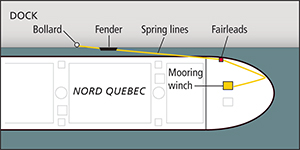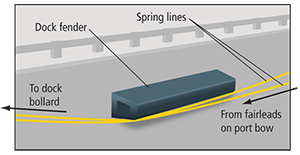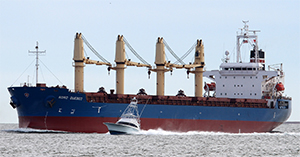The second officer on a bulk carrier was fatally injured in a mooring accident in Trois-Rivieres, Quebec, when a spring line caught under a rubber fender at the dock, sprung loose and struck him under the chin.
The 583-foot Nord Quebec was berthing in ballast condition on May 22, 2017, with the assistance of two harbor tugs when the incident occurred, according to a report from the Transportation Safety Board of Canada (TSB). The second officer was supervising the forward mooring of the vessel with three other crewmembers. The required pre-berthing risk assessment and toolbox meeting had been conducted with the crew involved, and the berthing and mooring plan had been discussed and agreed upon by the master and the pilot.
According to the TSB report, Nord Quebec’s mooring plan is “not uncommon” and follows standard seamanship practices: The two spring lines were the first lines sent ashore but were initially kept loose because the vessel was making way at a low speed toward the required position relative to the dock’s cargo loading gear. When the pilot determined that the ship was in position, its residual forward motion had to be stopped.
“While the two tugs maintained the vessel alongside the dock, the spring lines were tensioned to stop the vessel,” the TSB report said. “There was no room between the vessel’s hull and the dock fenders for the spring lines to straighten between the vessel’s fairleads and the dock’s bollard. Consequently, the two spring lines became caught under one of the dock’s rubber fenders.”
 |
|
Diagrams in the TSB’s accident report show Nord Quebec’s mooring arrangement when the fatal accident occurred, above, and its spring lines caught under one of the dock’s rubber fenders, below. |
 |
|
Courtesy TSB/Pat Rossi illustrations |
As the crew worked to free the two spring lines, the second officer leaned over the ship’s handrail to visually assess their status, bringing his upper body into the snap-back zone. He backed away from the snap-back zone following a verbal warning from one of the linesmen ashore, but shortly afterward again leaned over the handrail. Investigators could not determine why the second officer entered the snap-back zone again.
“As the vessel’s hull moved away from the rubber fender and the spring lines were freed, the energy stored in their synthetic fibers caused them to snap upward in a slingshot motion along Nord Quebec’s side shell plating,” the TSB wrote. “The first spring line went above the main deck handrail, fatally injuring the second officer.”
On Jan. 18, the TSB sent a marine safety information letter to Transport Canada (TC) sharing various statistics collected by the TSB and other member states of the International Maritime Organization (IMO). These statistics showed multiple mooring-related casualties in Canada and abroad, demonstrating the international profile of safety issues related to mooring operations on board merchant vessels.
Following receipt of the letter, Transport Canada representatives attended a meeting of the IMO’s Subcommittee on Ship Design and Construction, held in London at the end of January. The Canadian delegation prioritized participation in the working group for safe mooring operations, along with 25 other IMO member states and 13 non-governmental organizations.
Nord Quebec is owned by Norden Shipping Singapore Pte Ltd. and is managed by Dampskibsselskabet Norden A/S of Denmark. Following the accident, the manager immediately sent a safety information letter to all of its vessels, and a formal safety bulletin was distributed to the fleet soon after. A company safety campaign focusing on risk assessment was carried out — including preparing and implementing a mooring operation risk assessment — and the incident was discussed during the company’s 2017 annual officers’ seminar.

